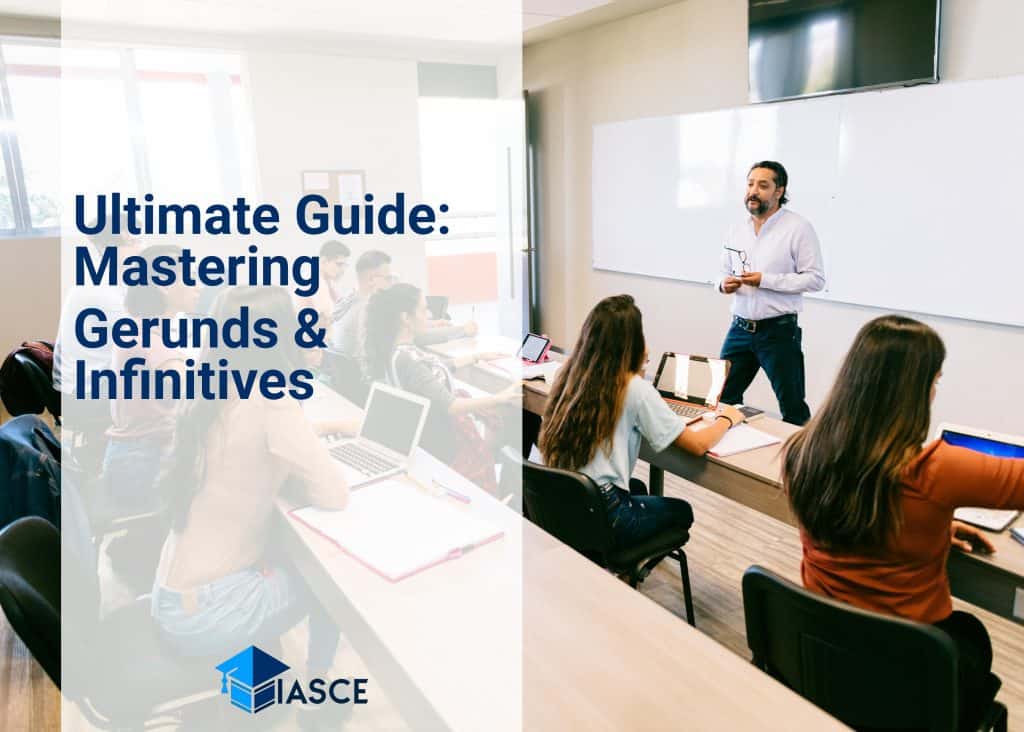Mastering gerunds and infinitives can feel like scaling a mountain. But trust me, it’s not as tough as you might think. I’m here to guide you through the rocky terrain of English grammar and get you to the summit.
First off, let’s clear up what these terms mean. Gerunds are verbs acting as nouns, ending in “-ing”. Infinitives? They’re the base form of a verb with “to”. Sounds simple, right? Well, it’s not always straight-forward when to use which. That’s where I come in.
I’ll help you navigate this tricky grammatical landscape, shedding light on common pitfalls and giving practical tips for usage. By the end of this journey together, gerunds and infinitives will be your friends, not foes.
Understanding the Basics of Gerunds
Diving right into the heart of grammar, let’s start with something that often confuses English learners – gerunds. A gerund is a verb form that ends in “-ing” and works like a noun in a sentence. Sounds tricky? It’s not once you get the hang of it.
Consider this example:
- Running is my favorite sport.
Here, ‘running’ acts as a subject—just like a noun would—making it a gerund.
Still fuzzy on the concept? Let’s break it down further. Essentially, any action word (verb) that transforms to look and act like a thing (noun), by adding an ‘-ing’, becomes what we call a ‘gerund’. So, in simple terms:
- Verb + -ing = Gerund
It’s worth noting that not all words ending in ‘-ing’ are gerunds though! For instance, if I say “I am running”, here ‘running’ isn’t acting as a noun but rather as part of the verb phrase “am running”. In such cases, these ‘-ing’ words are called present participles – but more about those later.
Let me share some more examples to help drive home the point:
| Sentence | Gerund |
|---|---|
| Swimming helps me relax | Swimming |
| I enjoy painting | Painting |
| Her hobby is baking | Baking |
See how each gerund can be replaced by other ordinary nouns like ‘soccer’, ‘movies’, or ‘music’? That’s your clue!
Now you’ve got the basics down, don’t forget to practice identifying and using gerunds in your daily conversations or writings. Trust me, they’re everywhere once you start looking!
Decoding Infinitives: A Deep Dive
Delving into infinitives can feel a bit like diving into the deep end of a pool. But don’t worry, I’m here to guide you all the way. First off, let’s get clear on what an infinitive is. It’s the base form of a verb, often preceded by “to”. Examples include “to run”, “to eat”, and “to dance”.
Now you might be wondering why we need infinitives at all. Well, they’re incredibly versatile! They can function as nouns, adjectives or adverbs in a sentence.
Consider these examples:
As noun:
- To read is fundamental.
As adjective:
- She had a desire to win.
As adverb:
- She left early to catch the bus.
Pretty neat right? But wait there’s more! Infinitives also play vital roles in sentences with modal verbs (such as ‘should’, ‘would’, ‘could’) and verbs followed by objects.
Here are some examples:
Modal verb + infinitive:
- You should go to bed early.
Verb + object + infinitive:
- I want you to understand this concept completely.
However, it’s essential not to confuse infinitives with gerunds (verb forms ending in -ing) even though both can function as nouns. For example,
Infinitive:
- I love to read.
Gerund:
- I love reading.
Though subtly different, these two sentences convey slightly different nuances – the first focuses on the action itself while the second emphasizes my enjoyment of that action.
By now you should have a much better understanding of how and when to use infinitives correctly. Remember practice makes perfect so don’t shy away from trying out these new concepts in your daily conversations or writings!
Conclusion: Mastering Gerunds and Infinitives
So, we’ve delved deep into gerunds and infinitives. By now, you should be comfortable with these two essential elements of English grammar. You’ll find they’re not as intimidating as they may initially seem. With some practice, their use becomes almost second nature.
Let’s recap what we’ve learned:
- Gerunds function as nouns in a sentence, they always end in “-ing”. They can act as subjects, direct objects, or objects of prepositions.
- Infinitives are the base form of a verb often preceded by “to”.
Here’s an example table that demonstrates their usage:
| Sentence | Explanation |
|---|---|
| “Swimming is fun.” | “Swimming” is a gerund used as a subject |
| “I like to swim.” | “To swim” is an infinitive used as the object of the verb |
The key to mastering gerunds and infinitives? Practice! Try to identify them when reading or listening to English content. It’ll help reinforce what you’ve learned here today.
Remember: it’s okay if you don’t get it right every time. Learning any new language takes time and patience (and yes, even native speakers mix them up sometimes!). The important thing is that you’re making progress. And with this guide under your belt, I’m confident that you’re well on your way!
Keep practicing and happy learning!

